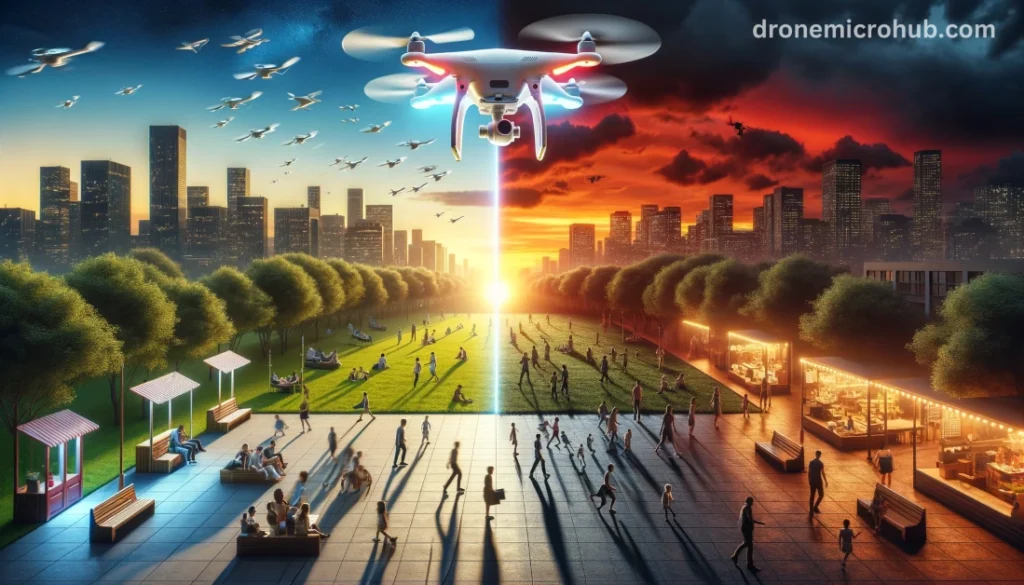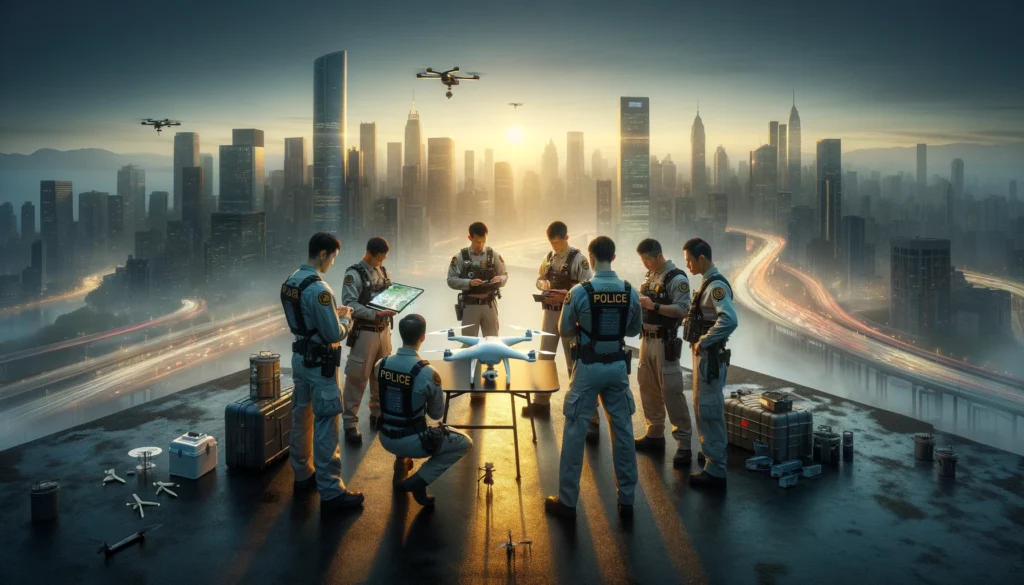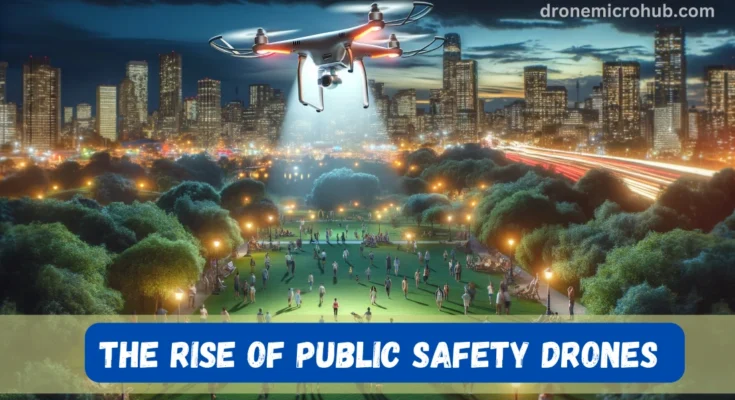Public safety has always relied on cutting-edge technology to protect communities and respond to emergencies. In recent years, drones, also known as unmanned aerial systems (UAS), have emerged as a powerful tool for public safety agencies across the globe. These public safety drones are transforming how first responders operate, drones and public safety go hand in hand for improved efficiency, faster response times, and potentially life-saving capabilities.
This comprehensive guide delves into the world of public safety drones. We’ll explore the various drones used for public safety, their real-world applications, and the benefits they bring to different public safety sectors. Whether you’re a firefighter, law enforcement officer, or simply a citizen interested in public safety, this article will equip you with a clear understanding of this revolutionary technology.
As FAA drone public safety regulations continue to evolve, public safety drone training becomes increasingly crucial. We’ll discuss the importance of proper training for drone operators and the qualifications needed to leverage this technology effectively.
Stay tuned for the next section where we’ll dive deeper into the specific applications of public safety drones. We’ll explore how these aerial platforms are enhancing various public safety operations, from search and rescue missions to disaster response and beyond.
Soaring to New Heights: Applications of Public Safety Drones
Public safety drones are revolutionizing various aspects of emergency response and preventative measures. Let’s explore some of the most impactful applications of these best public safety drones in action:
-
Search and Rescue:
Public safety drones equipped with thermal imaging cameras can scan vast areas quickly and efficiently, locating missing persons in dense forests, remote locations, or during nighttime operations. Their maneuverability allows them to navigate through challenging terrain inaccessible to traditional search parties, significantly improving the chances of finding lost individuals swiftly.
-
Firefighting:
Drones used for public safety play a critical role in firefighting efforts. They provide firefighters with a real-time aerial view of the blaze, helping them strategize fire containment and deployment of resources. Drones can also be used to drop water on small fires or deliver vital supplies to firefighters battling large wildfires.
-
Law Enforcement:
Public safety drones offer valuable assistance to law enforcement personnel in various situations. They can be used for surveillance of crime scenes, investigation of suspicious activity, and perimeter control during hostage situations. Public safety drone training for law enforcement emphasizes responsible use and adherence to privacy regulations.
-
Disaster Response:
In the aftermath of natural disasters like hurricanes, floods, or earthquakes, public safety drones become invaluable tools for damage assessment. They can provide a bird’s-eye view of affected areas, helping emergency responders identify areas in need of assistance, locate survivors, and coordinate rescue efforts.
-
Traffic Monitoring and Accident Reconstruction:
Public safety drones can be deployed to monitor traffic flow on busy roadways, identify accidents swiftly, and assess the situation from a safe distance. This allows for faster response times by emergency medical services and reduces congestion caused by accidents. Additionally, drones can be used to capture aerial footage of accident scenes, aiding in accident reconstruction investigations.
These are just a few examples of how public safety drones are transforming various public safety operations. As drone technology continues to develop, we can expect even more innovative applications to emerge in the future.
The next section will delve into the benefits of using public safety drones and some of the challenges associated with their integration.
Weighing the Scales: Benefits and Challenges of Public Safety Drones

Public safety drones offer a multitude of advantages for various emergency response scenarios. Here’s a closer look at some key benefits :
-
Enhanced Situational Awareness:
Public safety drones provide a real-time aerial view of situations, allowing responders to make informed decisions and strategize effectively. This improved situational awareness can significantly reduce risk for firefighters, law enforcement personnel, and search and rescue teams.
-
Improved Response Times:
The agility and speed of drones enable quicker deployment compared to traditional methods. In search and rescue missions, this can be the difference between life and death. Similarly, drones can help assess accident scenes or hazardous materials spills rapidly, leading to faster containment and mitigation efforts.
-
Reaching Difficult Locations:
Public safety drones excel at navigating challenging terrains or hazardous environments inaccessible by foot or vehicle. This allows responders to gather critical information and conduct operations in areas that would otherwise be too risky to access.
-
Cost-Effectiveness:
While there is an initial investment in purchasing and training for public safety drones, their long-term cost-effectiveness is undeniable. Drones can reduce the need for deploying helicopters or large search parties, lowering operational expenses for public safety agencies.
-
Data Collection and Analysis:
Public safety drones equipped with high-resolution cameras and LiDAR (Light Detection and Ranging) technology can capture valuable data from accident scenes, fire zones, or disaster areas. This data can be analyzed to improve future response efforts and enhance overall public safety strategies.
However, alongside these benefits, there are also challenges to consider regarding public safety drones:
-
Privacy Concerns:
The use of drones for surveillance raises concerns about privacy infringement. Public safety agencies implementing drone programs need to establish clear guidelines and protocols for data collection and usage to ensure public trust.
-
Safety Regulations:
FAA regulations regarding drone operation are continuously evolving. Public safety drone training must equip pilots with a thorough understanding of these regulations to ensure safe and legal operation of drones in controlled airspace.
-
Technical Limitations:
Battery life, weather conditions, and signal interference can limit the effectiveness of drones in certain situations. Best public safety drones are constantly being developed to overcome these limitations, but it’s essential to be aware of their current constraints.
-
Public Perception:
Negative public perception surrounding drone use can hinder community support for drone programs. Public safety agencies need to engage in open communication and education efforts to address concerns and demonstrate the responsible use of drones for public safety purposes.
By acknowledging these challenges and implementing responsible practices, public safety agencies can harness the immense potential of public safety drones to create a safer and more secure future for communities.
In the final section, we’ll explore some key considerations for public safety drone programs, including training, regulations, and choosing the best drones for public safety.
Taking Flight: Considerations for Public Safety Drone Programs

As public safety agencies embrace the potential of drones, establishing a well-defined drone program is crucial. Here are some key considerations:
-
Public Safety Drone Training:
Investing in comprehensive public safety drone training is paramount. This training should equip pilots with the necessary skills for safe and effective drone operation, including knowledge of FAA regulations, airspace restrictions, and emergency procedures. Additionally, training should cover specific applications relevant to the agency’s needs, such as search and rescue protocols or scene photography techniques.
-
Regulations and Compliance:
Staying up-to-date with the evolving FAA drone public safety regulations is essential. Public safety drone programs should designate a point person responsible for monitoring regulation changes and ensuring compliance within the program. This ensures safe operation and avoids potential legal repercussions.
-
Choosing the Best Drones for Public Safety:
With a wide range of public safety drones available, selecting the right model depends on the agency’s specific needs. Factors to consider include flight time, range, payload capacity, sensor capabilities (thermal imaging, LiDAR), and durability. Consulting with experienced drone professionals and evaluating different models based on performance specifications is crucial before making a purchase decision.
-
Community Engagement:
Open communication and public education are vital for building community trust in a public safety drone program. Agencies should proactively address privacy concerns and explain the benefits and limitations of drone use. Community outreach programs that demonstrate responsible drone operation can foster public support and acceptance.
-
Integration with Existing Systems:
For a seamless workflow, integrating public safety drones with existing communication and data management systems is important. This allows for real-time data sharing between drone pilots, command centers, and emergency response teams, facilitating a more coordinated and efficient response.
By carefully considering these factors, public safety agencies can establish successful drone programs that leverage this technology’s benefits while mitigating the challenges. Public safety drones have the potential to revolutionize emergency response, and with proper planning, training, and responsible implementation, they can significantly enhance public safety efforts.
Final Thoughts: The Future of Public Safety Soars High
Public safety drones represent a significant leap forward in emergency response capabilities. Their agility, data-gathering potential, and ability to access difficult locations are transforming how public safety agencies protect communities. As drone technology continues to evolve, we can expect even more innovative applications to emerge, further enhancing public safety measures.
Frequently Asked Questions (FAQs) about Public Safety Drones:
Q1. What is the safety of a drone?
Public safety drones, when operated by trained professionals following FAA regulations, can be very safe. These drones often incorporate safety features like geofencing to prevent unauthorized access to restricted airspace and automatic return-to-home functionality in case of signal loss.
Q2. What are safety systems for drones?
Several safety systems can be integrated into public safety drones. These include:
-
Geofencing:
Creates virtual boundaries that prevent drones from entering restricted airspace.
-
Sense and Avoid Systems:
Utilize sensors to detect and avoid obstacles, minimizing collision risks.
-
Automatic Return-to-Home:
Ensures the drone returns to its launch point in case of signal loss or battery depletion.
Q3. How can drones be used safely?
Safe drone operation hinges on several factors:
-
Proper Training:
Pilots must undergo comprehensive training to understand regulations, flight procedures, and emergency response protocols.
-
Following Regulations:
Adhering to FAA regulations regarding airspace restrictions, flight time limitations, and weight restrictions is crucial.
-
Maintaining Visual Line of Sight:
Operators should always maintain a visual line of sight with their drones to ensure control and avoid collisions.
Q4. Can civilians own drones?
Yes, civilians can own drones for recreational purposes. However, FAA regulations apply to all drone flights, regardless of purpose. It’s crucial for civilian drone operators to register their drones, understand airspace restrictions, and fly responsibly.
By prioritizing safety, responsible operation, and community engagement, public safety agencies can harness the immense potential of drones to create a safer future for all.




